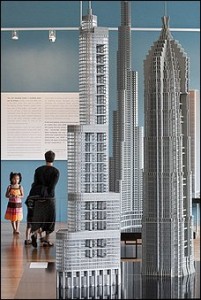Washington Post Staff Writer www.washingtonpost.com
Lots of people use the expression “think outside the box” to mean “be creative.” When Adam Reed Tucker uses it — and he uses it often — he’s talking literally about a cardboard box.

A cardboard box of Lego blocks.
The 38-year-old artist and architect was in Washington recently to help set up an exhibition of his work at the National Building Museum. Called “Lego Architecture: Towering Ambition,” the show features 15 miniature models of some of the world’s most famous buildings, built entirely out of Lego pieces. Did I say miniature? One of the works in the show is almost 18 feet tall and made from 450,300 Lego pieces. It’s a copy of the Burj Khalifa, a brand-new skyscraper in Dubai that, at 2,717 feet, holds the record as the tallest building in the world.
How tall is that? Tucker puts it this way: Chicago’s Willis Tower (it used to be called the Sears Tower) — still the tallest building in the United States — would fit inside it . . . nearly twice. (You’ll also find a model of the Willis Tower at the museum, along with the Empire State Building, St. Louis’s Gateway Arch, the White House and one of the World Trade Center’s twin towers.)
Tucker’s model of the Burj took 340 hours to build, plus 280 more to design. He doesn’t use glue. Or computers. The models, he says, are “100 percent Lego.” His design process? It’s a combination of imagination and trial-and-error. “I have the ability to ‘pixelize,’ I guess. I just see what looks good.”
That’s pretty cool. But Tucker isn’t trying to blow anyone away with his skills. He wants to inspire people to believe, as he does, that “anything is possible.”
Sure, he says, whenever you buy a box of Lego pieces, you get an instruction booklet telling you the right way to put them together. Nothing wrong with that. There’s even a gift shop next to the exhibition where you can take home tabletop-size versions of some of Tucker’s models. That’s how he makes his living these days: by designing Lego kits based on famous buildings.
But Tucker would be even happier if you put down the manual for a minute or two and, you know, used your head. There’s a play area next to the exhibition where kids and grown-ups are encouraged to build a city — without any directions.
“When I look at a box of Legos,” he says, “I don’t see a box of blocks. I see a box of ideas.”
By Michael O’Sullivan












